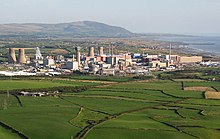
Back إعادة المعالجة النووية Arabic Reprocessament nuclear Catalan Přepracované jaderné palivo Czech Wiederaufarbeitung German Reprocesamiento nuclear Spanish بازیافت هستهای Persian Traitement du combustible nucléaire usé French नाभिकीय पुनर्सन्साधन Hindi Pemrosesan ulang nuklir ID Riprocessamento Italian
This article includes a list of general references, but it lacks sufficient corresponding inline citations. (May 2012) |

Nuclear reprocessing is the chemical separation of fission products and actinides from spent nuclear fuel.[1] Originally, reprocessing was used solely to extract plutonium for producing nuclear weapons. With commercialization of nuclear power, the reprocessed plutonium was recycled back into MOX nuclear fuel for thermal reactors.[2] The reprocessed uranium, also known as the spent fuel material, can in principle also be re-used as fuel, but that is only economical when uranium supply is low and prices are high. Nuclear reprocessing may extend beyond fuel and include the reprocessing of other nuclear reactor material, such as Zircaloy cladding.
The high radioactivity of spent nuclear material means that reprocessing must be highly controlled and carefully executed in advanced facilities by specialized personnel. Numerous processes exist, with the chemical based PUREX process dominating. Alternatives include heating to drive off volatile elements, burning via oxidation, and fluoride volatility (which uses extremely reactive Fluorine). Each process results in some form of refined nuclear product, with radioactive waste as a byproduct. Because this could allow for weapons grade nuclear material, nuclear reprocessing is a concern for nuclear proliferation and is thus tightly regulated.
Relatively high cost is associated with spent fuel reprocessing compared to the once-through fuel cycle, but fuel use can be increased and waste volumes decreased.[3] Nuclear fuel reprocessing is performed routinely in Europe, Russia, and Japan. In the United States, the Obama administration stepped back from President Bush's plans for commercial-scale reprocessing and reverted to a program focused on reprocessing-related scientific research.[4] Not all nuclear fuel requires reprocessing; a breeder reactor is not restricted to using recycled plutonium and uranium. It can employ all the actinides, closing the nuclear fuel cycle and potentially multiplying the energy extracted from natural uranium by about 60 times.[5][6]
- ^ Andrews, A. (27 March 2008). Nuclear Fuel Reprocessing: U.S. Policy Archived 3 March 2016 at the Wayback Machine. CRS Report For Congress. Retrieved 25 March 2011
- ^ MOX fuel can extend the energy extracted by about 12% but slightly reduces plutonium stocks. Information from the World Nuclear Association about MOX Archived 1 March 2013 at the Wayback Machine
- ^ Harold Feiveson; et al. (2011). "Managing nuclear spent fuel: Policy lessons from a 10-country study". Bulletin of the Atomic Scientists. Archived from the original on 26 April 2012. Retrieved 8 July 2011.
- ^ "Adieu to nuclear recycling". Nature. 460 (7252): 152. 2009. Bibcode:2009Natur.460R.152.. doi:10.1038/460152b. PMID 19587715.
- ^ "Supply of Uranium". World Nuclear Association. Archived from the original on 12 February 2013. Retrieved 29 January 2010.
- ^ "Fast Neutron Reactors". World Nuclear Association. Archived from the original on 24 February 2013. Retrieved 11 March 2012.
© MMXXIII Rich X Search. We shall prevail. All rights reserved. Rich X Search